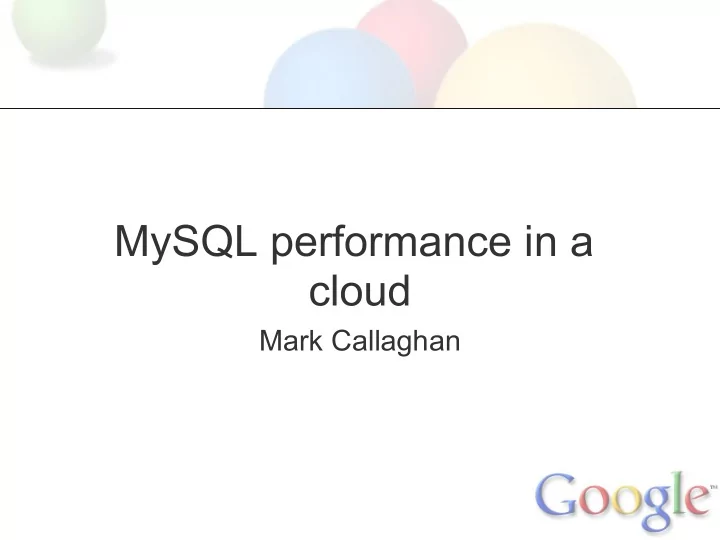

MySQL performance in a cloud Mark Callaghan
Special thanks Eric Hammond (http://www.anvilon.com) provided documentation that made all of my work much easier.
What is this thing called a cloud? Deployment trends Technology Public versus private
Deploying MySQL in a cloud New problems New benefits Differences from traditional deployment Performance can be good, but ... Virtualization techniques matter May need InnoDB patches to tolerate IO latency
Impact from requirements Database in direct attached storage: backups and binlogs archived in the cloud use MySQL replication to maintain a failover target less can go wrong Database in network attached storage another MySQL server can takeover on failure
Focus on InnoDB performance Network attached storage Direct attached storage Multi-core servers Virtualization overhead Patches that improve performance
Benchmarks Start with simple benchmarks iibench IO bound workload great for finding bottlenecks in storage engines started by Tokutek sysbench OLTP workload wisconsin query processing workload
What is different? Not much, MySQL runs great here Multi-core scalability matters because 8-cores costs more May need ability to tolerate IO latency
Make InnoDB faster link with tcmalloc use XFS reduce mutex contention for multi-core servers IO performance multiple background IO threads increase IO rate on busy servers
Factors for IO latency O_DIRECT versus buffered IO SATA writeback cache Flash erase cycles Network versus direct attached storage IO scheduler Excessive prefetching from the OS Hardware RAID write cache File system limits on concurrent reads/writes per file Ability of storage engine to issue concurrent IO requests
Tuning for IO bound loads innodb_read_io_threads In Percona and Google patches Helps when there is a lot of prefetching for full table scans innodb_write_io_threads In Percona and Google patches Helps when writes have a lot of latency Writes have a lot of latency when: using O_DIRECT without SATA writeback cache using O_DIRECT without HW RAID write cache using network attached storage
Tuning for IO bound loads (2) innodb_io_capacity In Google and Percona patches Helps when there are many writes to issue faster IO Increases rate at which background IO is done Increase size of IO request arrays Google and Percona patches have changes for this SHOW INNODB STATUS Google and Percona added more output Google patch includes average IO time for reads and writes
Network attached storage tests Server: 2 CPU cores, 4G or 8G RAM SW RAID 0 striped over 4 network volumes 1M RAID stripe size XFS MySQL 5.0.37 + v3 Google patch + tcmalloc Innodb with 1G buffer pool, O_DIRECT, innodb_flush_log_at_trx_commit=2
Concurrent query performance with network attached storage: 4 concurrent queries, IO bound
iibench insert rate
iibench QPS rate from 4 threads concurrent with inserts
Direct attached storage tests Server: 2 CPU cores, 4G or 8G RAM SW RAID 0 striped over 2 disks 1M RAID stripe size XFS Innodb with 1G buffer pool, O_DIRECT, innodb_flush_log_at_trx_commit=2 MySQL 5.0.37 + v3 Google patch + tcmalloc
Concurrent query performance with direct attached storage: 2 concurrent queries, IO bound
iibench insert rate
Direct attached storage tests (2) Server: 8 CPU cores, 4G or 8G RAM SW RAID 0 striped over 10 disks 1M RAID stripe size ext-2 Innodb with 1G buffer pool, O_DIRECT, innodb_flush_log_at_trx_commit=2 MySQL 5.0.37 + v3 Google patch + tcmalloc
Time to load 50M rows in iibench
Row insert rate while loading 50M rows in iibench
Multi-core servers How do MySQL and InnoDB scale on SMP? Test configuration: CPU bound workload MySQL 5.0.37 with v3 Google patch 4, 8 and 16 core servers mysqld linked with tcmalloc
CPU speedup without virtualization: modified sysbench readonly, CPU bound measure transactions per second
CPU speedup without virtualization: modified sysbench readwrite, CPU bound measure transactions per second
Virtualization overhead KVM tests Ubuntu 8.04 4 core server, 1 disk, 4G RAM, supports AMD-V MySQL 5.0.77 with tcmalloc MySQL 5.0.37 with v3 Google patch and tcmalloc Note that KVM is much improved since this version Xen tests Linux 2.6 8 CPU cores, enough RAM to cache database hardware on server with Xen faster than non-Xen server Xen server has 4 disks in SW-RAID 0 using XFS, 16G RAM MySQL 5.0.37 with tcmalloc and v3 Google patch
KVM random IO performance: sysbench fileio rndrd, 8G file
Xen random IO performance: sysbench fileio rndrd, 16G file
KVM sequential IO performance: sysbench fileio seqrd, 8G file
Xen sequential IO performance: sysbench fileio seqrd, 16G file
KVM sequential IO performance: hdparm -t, hdparm -T
KVM CPU performance: modified wisconsin benchmark, CPU bound measure time to run all queries
KVM CPU performance: modified sysbench readonly, CPU bound measure transactions per second
KVM CPU performance: modified sysbench readwrite, CPU bound measure transactions per second
Xen CPU performance: modified sysbench OLTP readonly, CPU bound
Xen CPU performance: modified sysbench OLTP readwrite, CPU bound
iibench insert rate comparing 2 local disks versus 4 network volumes
iibench QPS rate comparing 2 local disks versus 4 network volumes
Patches All of these changes are available in some combination of the v3 Google patch, Percona builds and now .... MySQL 5.4!
Make appropriate choices remote versus direct attached storage configuration storage engine IO scheduler file system patches
Recommend
More recommend